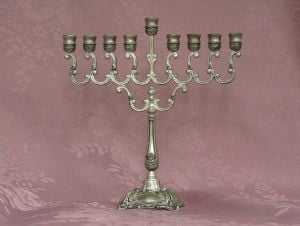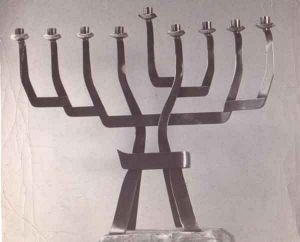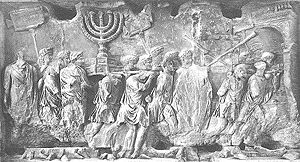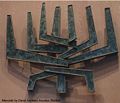Menorah
The menorah (Hebrew: מנורה) (a seven or nine branched candelabrum), is one of the oldest symbols of the Jewish people. The menorah once played a central role in the Tabernacle and the Temple in Jerusalem. It is said to symbolize the burning bush as seen by Moses on Mount Sinai (Exodus 25), and thus represents the light of God.
A special type of Menorah, known as a Chanukkiyah or Hanukiah, is also associated with the Jewish holiday of Hanukkah and symbolizes the miracle of the eight days of light provided by the menorah in the Temple of Jerusalem following the Maccebean revolt of (insert date).
Origin and Ancient use
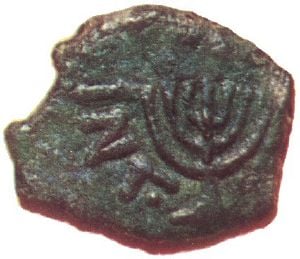
The Torah states that God revealed the design for the menorah to Moses. A menorah used in the Tabernacle (the portable sanctuary used by the Jews) and later in its successor, the Temple in Jerusalem was forged from a single piece of gold. A lamp burning olive oil was located at the end of each of the seven branches. Since the destruction of the Temple ground, the seven-branched menorah has had no formal role in Jewish worship. Because of the sanctity of the Temple and its appointments, some authorities forbid the manufacture of menorah resembling the one used there.[1]
Hanukkah menorah (nine branched candelabrum)
The Menorah is also a symbol closely associated with the Jewish holiday of Hanukkah. According to the Talmud, after the desecration of the Jewish Temple in Jerusalem, there was only enough sealed (and therefore not desecrated by idolatry) consecrated olive oil left to fuel the eternal flame in the Temple for one day. Miraculously, the oil burned for eight days which was enough time to get new oil as well as finish rebuilding the Temple. The Hanukkah Menorah therefore has not seven, but nine candle holders. The four holders on either side are to represent the eight day celebration of the miracle of oil, while the one in the middle, called the Shamash, is used to light the others. While this type of menorah is technically called a Hanukiah, the "menorah of Hanukkah" is sometimes simply called a menorah.
The Chanukkiyah or Hanukiah, (Hebrew: חַנֻכִּיָּה) is a nine-branched candelabrum lit during the eight-day holiday of Hanukkah. The ninth branch is for a candle used to light all other candles called the shamash. The chanukkiyah has two branches more than a menorah. In the diaspora, the chanukkiyah is also commonly called a "Hanukkah menorah" '. The name "chanukkiyah" was given only in the end of the nineteenth century in Jerusalem by Eliezer Ben Yehuda's wife, the revivor of the Hebrew language.
Hanukkah celebrates the rededication of the Temple after the successful Jewish revolt against the Seleucid monarchy. According to the Talmud, the victorious Jews found only enough ritually pure olive oil to light the menorah for one day, but the supply miraculously lasted eight days until a new supply could be obtained. In celebration of this miracle, the chanukkiyah has eight branches for eight candles or oil lamps, none higher than any other, except for one higher branch for the auxiliary candle, or shamash, which guards against secular use of the other lights and is also used to light them. The common reason for the number of the candles is that they symbolize the eight days of the miracle. Each night an additional light is kindled – one on the first night, two on the second night; and so on – until on the eighth night of Hanukkah all eight lights, plus the shamash, are lit. Another possible reason for the eight branches of the Chanukkiyah, as opposed to the seven in the traditional menorah in the temple, may be because according to halakha, it is forbbiden to make a menorah similar to the one in the temple because of its sanctity.
Another interpretation for the eight-day ceremony is that it commemorates the story of Hannah and her seven sons. The story depicted in the Talmud and in the Book of Maccabees accounts how Hannah's seven sons were tortured and executed according to Antiochus' policy when they refused to bow to a statue and to taste pork. Hannah herself committed suicide after the death of her sons.
Meaning
A plant that grows in Israel called the moriah typically has seven branches and resembles a menorah, leading to the theory that it provided the inspiration for its design. According to some readings, Maimonides stated that the menorah in the Temple had straight branches, not rounded as is often depicted.[2] Jewish depictions of the menorah dating back to Temple times, along with the depiction on the Arch of Titus showing the Romans taking the looted Menorah to Rome after the Temple's destruction, contradict this claim.
A second theory to the origin of the design of the menorah is based on what is known about ancient Hebrew cosmology. According to this theory, the seven branches represent the seven heavenly bodies known at the time, namely the sun and the moon, as well as Mercury, Venus, Mars, Jupiter and Saturn. The Jewish historian Josephus alludes to this in the Third Book of his Antiquities of the Jews. In it, he identifies what he interprets as Egyptian and Greek pagan influences on the design of the Tabernacle and its contents. He writes:
"...for if any one do without prejudice, and with judgment, look upon these things, he will find that they were every one made in way of imitation and representation of the universe...and as to the seven lamps upon the candlesticks, they referred to the course of the planets, of which that is the number....".
A third theory is that the menorah originated as the tree of life symbolizing the mother goddess Asherah.[3] In the Pentateuch, it has been purged of all polytheistic symbolism.
Fate
The fate of the menorah used in the Second Temple is recorded by the Jewish historian Flavius Josephus, who states that it was brought to Rome and carried along during the triumph of Vespasian and Titus. A depiction of this event is preserved on the Arch of Titus that still stands today in Rome.
The menorah probably remained in the Temple of Peace in Rome until the city was sacked by the Vandals in 455 C.E., and was brought to their capital, Carthage. But the Byzantine army under General Belisarius took it back in 533 and brought it to Constantinople. According to Procopius, it was carried through the streets of Constantinople during Belisarius' triumphal procession. Procopius adds that the object was later sent back to Jerusalem. This may be a pious legend.
Modern use
Many synagogues display either a menorah or an artistic representation of a menorah. In addition, synagogues feature a continually-lit lamp in front of the Ark, where the Torah scroll is kept. Called the ner tamid, this lamp represents the continually-lit menorah used in Temple times. A menorah appears in the Coat of arms of the State of Israel.
The Coat of Arms of Israel shows a menorah surrounded by an olive branch on each side and the writing "ישראל" (Israel)
ReferencesISBN links support NWE through referral fees
- ↑ Mishneh Torah Avodah Laws of the Temple 7:9
- ↑ The shape of the Menorah of the Temple (Avodah Mailing List. Volume 12: Number 065. Friday, December 26 2003)
- ↑ Asherah, the Tree of Life and the Menorah
External links
- A collection of articles regarding the menorah in the temple on chabad.org
- Menorahs
- Menorah at Livius.Org
- "Lighting the Way to Freedom" by Aaron Ha'Tell and Yaniv Ben Or, Devorah Publishing (2006). ISBN 1-932687-66-1
- Instructions for lighting the Chanukah Menorah on chabad.org
Credits
New World Encyclopedia writers and editors rewrote and completed the Wikipedia article in accordance with New World Encyclopedia standards. This article abides by terms of the Creative Commons CC-by-sa 3.0 License (CC-by-sa), which may be used and disseminated with proper attribution. Credit is due under the terms of this license that can reference both the New World Encyclopedia contributors and the selfless volunteer contributors of the Wikimedia Foundation. To cite this article click here for a list of acceptable citing formats.The history of earlier contributions by wikipedians is accessible to researchers here:
The history of this article since it was imported to New World Encyclopedia:
Note: Some restrictions may apply to use of individual images which are separately licensed.

